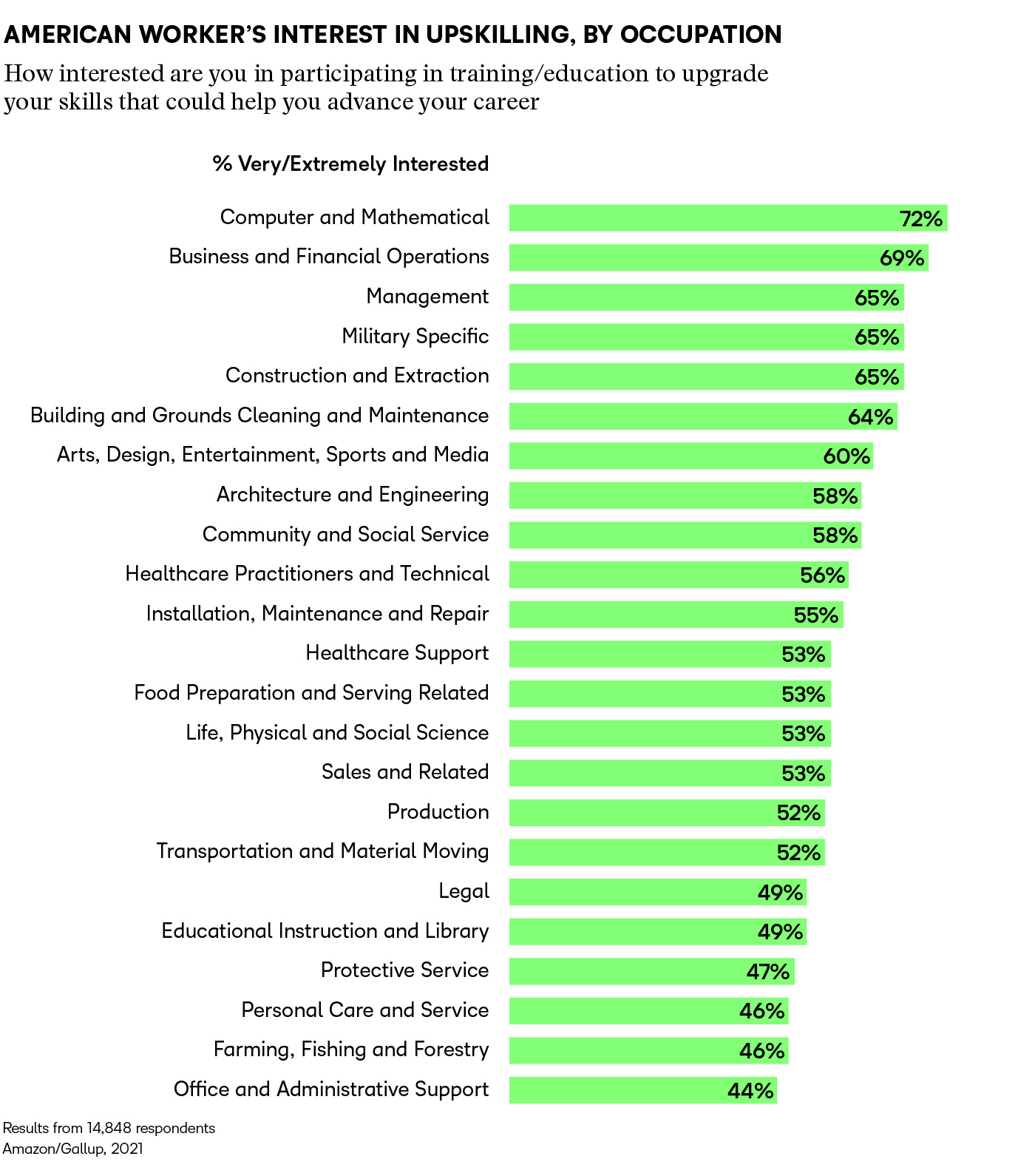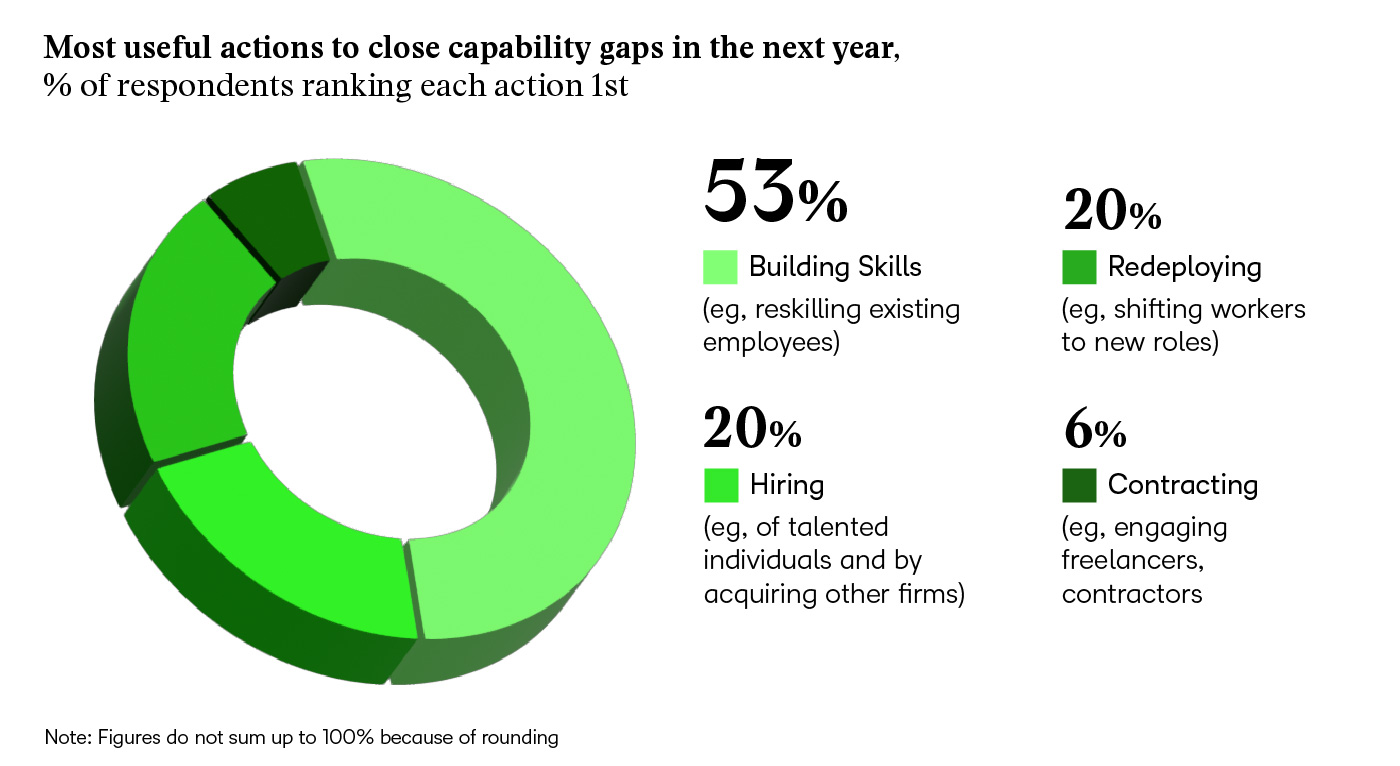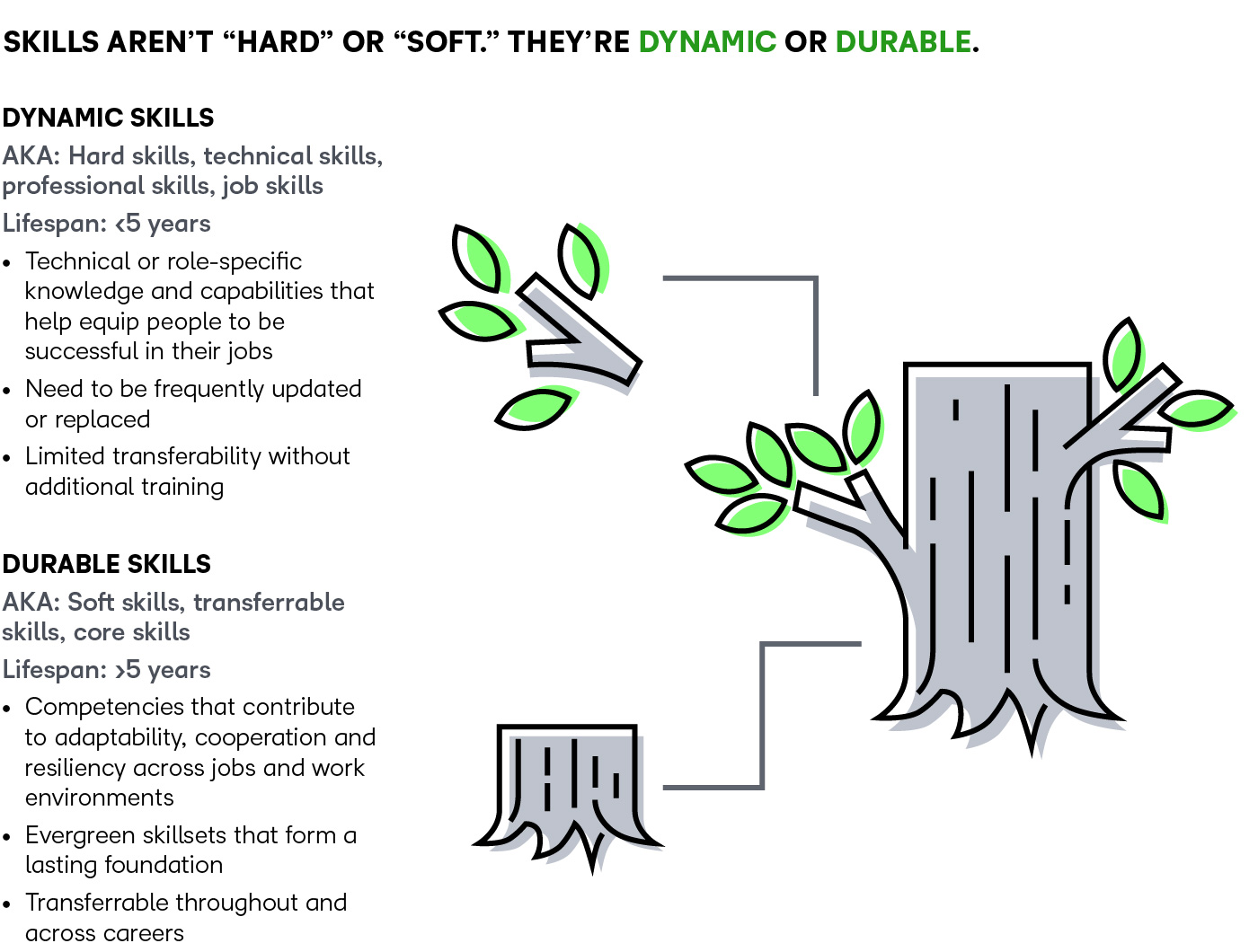People are more educated than ever before. In the U.K. alone, 44% of all 18-year-olds applied to university courses in January 2022, 11% more than in 2013. In 2022 over five million U.K. students took GCSEs. And from 1980 to 2020, global literacy increased from 68% to 86%. However, that boost in education hasn’t equated to smooth sailing in the labour market.
Employers are aware of being left behind as digital transformations, artificial intelligence (AI) and machine learning (ML) adoption, and the shift to remote work all accelerate. This can be seen in job postings, which now ask for a combination of functional, interpersonal and technical skills.
When it comes to closing any skills gaps, upskilling is vital to any L&D strategy. Not only can it help to future-proof organisations, but it also enables companies to address challenges such as employee engagement and retention.
In this blog, we’ll explore how to develop and implement an upskilling strategy within your business. We’ll cover:
What is upskilling?
- The difference between upskilling and reskilling
- How to upskill: conducting a gap analysis
- How to upskill: creating a strategy
- How to upskill: communicating your objectives
What is upskilling?
Upskilling initiatives give employees the opportunities to access the knowledge and expertise needed to progress within their current career path. For companies, it’s about building more-resilient, future-forward organisations that are equipped to tackle tomorrow’s challenges with internal talent.
Hiring specialists to fill skills gaps is more challenging than ever in today’s labour market. Around one-fifth of UK workers, said they planned to leave their jobs, according to a report by PwC and 1.3 million jobs were unfilled as of June 2022, motivating employers to overhaul their talent strategies.
There is plenty of evidence that this is being put into effect. Amazon has pledged to invest $1.2 billion in upskilling its employees by 2025. In 2020, Microsoft launched initiatives to upskill 25 million people globally. And Salesforce is providing free, immersive upskilling opportunities for prospective employees, leading it to commit to creating 9.3 million new jobs worldwide by 2026.
As organisations accept that they can’t simply hire people to fill skills gaps, investment in learning and development (L&D) has skyrocketed. LinkedIn’s 2022 Workplace Learning Report saw demand for L&D specialists increase 94% from July through September 2020 to April through June 2021.
“Having a learning plan and a system in place to support that plan helps with growth and retention,” says John Baker, president and CEO of D2L. “In a world where talent is a top-three issue for every CEO, we need to move quickly to put in place a better learning experience—for onboarding, upskilling and leadership development. No leader wants to lose the talent they have, and the key to this is investing in individual employee growth. Upskilling drives retention, supports transformation efforts and builds a growth culture—and is key to retaining talent and attracting people who see your company as the best place to grow in their career.”

What makes upskilling successful?
Successful upskilling programmes align learning and development with long-term business strategies to address widening skills gaps. As a result, we’re now witnessing a shift from people ops being seen as an administrative cost centre to a strategic, revenue-generating partner.
Upskilling fosters a culture of internal growth and can improve retention by promoting from within. LinkedIn’s 2022 Workplace Learning Report found that companies that excel at internal mobility retain employees for 5.4 years on average, almost twice as long as companies that don’t.
While upskilling is primarily a retention strategy, it can also help companies attract well-qualified, high-potential employees. Amazon and Gallup’s upskilling study of 15,000 workers in 2021 found that 48% of employees would switch to a new job if it came with skills training. Also, skills gaps are often greater in underrepresented groups, so upskilling can be a key component of a diversity, equity and inclusion strategy.

SOURCE: The American Upskilling Study (Gallup, commissioned by Amazon)
Adopting a varied programme
To meet demand, companies are beginning to offer diverse upskilling programmes to cater to the variety of skills they’re focused on improving within their teams.
Some of the most common upskilling programmes include:
- Microlearning, which makes training easy to fit into busy schedules
- An upskilling curriculum offered through a learning management system
- Peer mentorship between more senior and less experienced employees
- Skill sharing to provide a platform for team members to discuss what they’re learning
- Boot camps that combine theory and practice to nurture a functional technical skill
- Tuition reimbursement for relevant certificate programmes or degrees

SOURCE: Enabling Upskilling at Scale (D2L)
Upskilling programmes aren’t a one-size-fits-all for employees, teams or companies. Commonly cited examples of upskilling programmes come from massive organisations, but small companies can and should prioritise upskilling too.
“Employees need access to programs to help build their skills throughout their careers and employers need the means to provide that training to maintain skilled talent,” says Baker. “But it’s clear from our research that many small and midsized enterprises in North America are struggling to provide these valuable upskilling opportunities for their employees, even as their employees are looking for ways to keep learning. This is a big problem that will only get worse if we, together, don’t act soon to help solve it.”
If you’re a small company short on resources, there are still plenty of ways to help your team members upskill. For example, providing recommended resources, training time and an L&D stipend with clear guidelines (aligned with your long-term strategy) can encourage bottom-up upskilling.
Upskilling or reskilling: what’s right for you?
Providing opportunities for upskilling is one of the most important parts of any organisation’s learning and development strategy. Without opportunities to advance their careers, talented employees will leave organisation and money will need to be spent on recruitment—to secure the skills that could have been developed in-house at a fraction of the cost.
| Upskilling | Reskilling |
|---|---|
|
|
Why upskill and reskill?
Cassie Naji is the vice president of people development at Animalz, a 150-person B2B content marketing agency. She heads a department dedicated to creating and executing learning and development strategies.
“Within that strategy, I would say that over 50% of activities need to be dedicated to upskilling”, she says. “That weighting is down to the economic imperative of upskilling—helping a tenured team member build on their baseline skill set often makes greater business sense than hiring a new, specialised person.”
That doesn’t mean that reskilling should be overlooked or denied attention and investment. Remember that reskilling helps the same workers you already believed in enough to hire, giving them new skills that are more closely aligned with the organisation’s evolving needs.
Briefly, while upskilling enables vertical talent mobility, reskilling supports horizontal talent mobility between and across teams that can be just as valuable to your organisation.
Upskilling and reskilling: working in tandem
Upskilling and reskilling can work in tandem. If you have a team with limited digital skills, for example, you may start by upskilling them to improve their digital literacy.
Equally, suppose you’re looking to leverage more artificial intelligence and machine learning to reduce monotonous analogue work. In that case, this may be the first step towards reskilling people for high-impact jobs—as increased efficiency may eventually decrease headcount needs in their department.

In the age of automation, reskilling is also a key component of corporate social responsibility. McKinsey & Company research encourages companies to think beyond bottom-line business interests, using automation as an opportunity to serve long-term societal goals and create new, higher-skilled opportunities. Organisations including Verizon, Accenture and Intel are already running reskilling programmes to help employees transition into new roles.
Seeing things differently
This feeds into a wider debate about the role of reskilling. An effective reskilling strategy can save companies money on finding new employees, but it also serves a wider social purpose. Being able to say that employees are being reskilled rather than made redundant reflects positively, especially as investors become more concerned about how a company behaves and performs.
It also allows the company to position itself as an ethical, engaged employer. And in a time when job candidates spend time researching employers on sites such as Glassdoor and LinkedIn, it makes it more likely that they will attract high-quality candidates.
Whether you choose to upskill or reskill depends on the employee, the target role and the organisation’s needs—as well as its wider social responsibility.
How to upskill your employees
The upskilling requirements in your business are a moving target, given the pace of innovation and the available talent. Not only do many employees already lack some of the key skills they need to do their jobs effectively, but those gaps are increasing.
Emerging technologies such as artificial intelligence, machine learning and robotics have moved the conversation on—from a fear that technological advances will take away jobs to the fact that they create new opportunities that need very different skills. The problem is that many organisations are underprepared. LinkedIn found that the skill sets needed for jobs have shifted by around 25% since 2015. By 2027, the research projects that number will hit 50%.

SOURCE: The skillful corporation (McKinsey & Company)
How can a company successfully address this widening skills gap? Before 2021, the focus may have been on hiring. Today, however, most companies are turning instead to upskilling and reskilling.
To upskill employees, your organisation needs to:
- Perform a skills gap analysis
- Develop an upskilling strategy
- Communicate, implement and iterate your upskilling strategy
What is a skills gap analysis?
A skills gap analysis evaluates your organisation’s competencies and what it needs to do to achieve its current and future goals. It’s a multiphase project requiring a plan to:
- Evaluate areas of opportunity with your leadership team
- Collect feedback through surveys
- Measure existing skills
- Analyse results to inform your strategy
Start with the leadership team
Start the process by sharing with your leadership team what you want to achieve through upskilling and asking for their input. Questions could include:
- What skills do we require to serve our customers better?
- What skills are most important to us as a company?
- What jobs are currently difficult to hire?
- What goals do we have that will require skills we don’t currently possess?
- What roles do we anticipate needing over the next 12-18 months?
Use employee surveys
Conversations with the leadership team can set the stage for more detailed follow-up with employees through targeted surveys. With this two-pronged approach, you get the top-down and bottom-up input required for successful skills assessments ahead of strategic planning.
Make sure that surveys contain a balance of quantitative and qualitative questions to measure results with sufficient context to understand nuance and drive change. Quantitative responses can give you solid data points to anchor, while qualitative feedback from employees can shed light on actual and perceived skills gaps.
Questions should also assess the skills needed to achieve short- and long-term goals, including blocks to upskilling efforts. For example:
- What skills will help you achieve your goals?
- What skills would benefit you or your team from more training?
Other factors to consider might include things that could get in the way of building new skills, such as:
- Current workload
- Programme design
- Familiarity with company tools
- Lack of digital skills
- Manager support
Surveys should be framed in a way that encourages honest answers. When possible, anonymise surveys to prevent fear of censorship that could limit the success of your upskilling programme design.
Measure existing skills
Once you determine the perceived gaps, you can get more specific through structured skills assessments. This will also allow you to establish a baseline to improve from and communicate progress across the organisation as you roll out upskilling programmes.
Make people feel safe by discussing gaps in a solution-oriented way and being transparent about why upskilling is a priority. You can only close a gap if you know it exists.
It’s important to be clear that this collaborative effort will lead to individual and collective success. And you can achieve this by getting opinions from across the organisation. Communicating throughout the process will also give employees confidence in your intentions.
Analyse results and develop a strategy
Once you have input from leadership and the team, it’s time to identify the highest priorities. Map trends in the data to the organisational goals established with your leadership team.
- Which gaps are the biggest?
- Which is the most urgent?
- What obstacles might you face in implementing a strategy?
Upskilling is a continuous process. While you may emerge from the analysis phase with a seemingly endless list of skills gaps, you can set monthly or quarterly goals to make consistent progress.
Part of your analysis should also clarify what is in and out of scope for upskilling efforts. Not all skills gaps will require training. Some may require you to update processes or systems, while others might lead to restructuring roles—or the organisation.
Time to get strategic
Upskilling strategies can be built in-house or by partnering with an upskilling expert who can help you design a programme for current and future success.
There are three basic elements to bear in mind when developing an upskilling strategy:
- Establish clear goals aligned with the company strategy
- Create a plan
- Collaborate with stakeholders
1. Align with strategy
To maximise its impact, your upskilling strategy should align closely with your business strategy. You can set and track goals at organisational, departmental and individual levels that cover:
- How many people are you reaching through upskilling
- The number of upskilling paths your programme offers
- How have your efforts addressed skills gaps since the initial rollout
- The impact on any key performance indicators you track for your business
When setting goals, remember that organisations must develop dynamic and durable skills. Some may become outdated as goals or systems change, but many can be long-term investments.

2. Create a plan
“High staff turnover hurts companies. But it’s usually a symptom of a deeper issue about job satisfaction, which is driven by learning and development”, says D2L’s CEO, John Baker. “Don’t get stuck in a downward spiral. Create positive momentum—with people learning new skills, sharing insights with others, and helping the company grow and transform. It all starts with making sure your people can see a pathway to personal growth through learning and development.”
Many L&D leaders use the 70-20-10 model of balancing learning between on-the-job (70%), collaborative (20%) and classroom training (10%). It’s about moving beyond conventional training to become more engaging and effective, enabling people to learn in the flow of work.
In developing an implementation plan, ask questions such as:
- What is the best learning experience to gain each skill?
- How can we integrate theoretical and practical learning with work?
- Who can teach each skill, and what resources will they need?
- What will we measure, and how often will we report on our findings?
An integrated upskilling plan may be overseen by L&D leaders but will require input and buy-in from all department leads, including ops and finance.
One way to address the skills gap is through clear development levels for each role and a business model that factors in the time needed to ramp up plus the time needed for ongoing upskilling.
As Manoj Jonna, CEO of Ramped, a job discovery and skilling platform, says, “Ideally, upskilling is accounted for in your teams’ regular workload. Please don’t take precious personal time away from them”. Employees are more likely to take advantage of upskilling opportunities if they’re offered during paid work hours.
3. Collaborate with stakeholders
The best learning and development leaders communicate effectively across functions and understand how to tie upskilling initiatives back to the goals of each department. They also know they may face resistance in implementation and plan for that in their strategy.
For companies to close the skills gap, leaders across the organisation must understand the positive impact upskilling will have in both the short and long term in terms of hours and money saved. Learning and development leaders succeed when they demonstrate the fiscal impact of increased employee efficacy over time and become advocates for helping other leaders figure out how to build upskilling into the working week.
Asking open-ended questions and enlisting other stakeholders as partners will lead to the best outcomes.
- What meetings could be held less frequently, asynchronously or skipped entirely?
- How might employees be empowered to structure their schedules?
- Where are the opportunities to focus on process improvement?
When building out your upskilling strategy, be sure to factor in time for audits and updates. The best upskilling programmes are actively maintained and iterated.
Communicate, implement and iterate
Effective communication makes the difference between team members dreading training and being excited about opportunities to improve. Your first step toward getting teams on board is communicating your upskilling strategy in every available forum and channel, starting with leadership. A learning culture is the basis for success here.
Give every department time to talk to their teams in small groups and one-on-one sessions. Be a resource by providing templated communication so everyone can share the same vision and goals tailored to their team’s needs.
To address any fears around automation, each team member needs to understand how their work and progress tie back to the team and organisational success. They need to see how upskilling offers them opportunities to grow within the organisation.
Communication goes beyond just vision and strategy, however. Team members should understand the how and what behind your upskilling programme. When communicating, make sure:
- Time is scheduled for upskilling
- People know how to sign up
- Everyone has the necessary access
- There’s a central place for questions and updates
- Leaders across the organisation are available as resources
Increase accountability and take advantage of the opportunities to talk about your upskilling programmes—by writing about them on your company blog or social media, for example. Once you implement your strategy, highlight success stories across your team.
Implement and report
Plan to consistently resurface upskilling opportunities to encourage employees to continue to opt-in. Celebrate early wins, no matter how small. And ask for feedback within each training initiative to develop a strong feedback loop.
Every person joins your organisation with different experiences and skills, so use individual development plans to set clear goals that address areas of opportunity for each employee, create customised timelines and ensure no one is left behind. Department leaders can enable upskilling success by incorporating programme reviews and skills assessments into regular one-on-ones.
Leaders who help team members foresee and plan for barriers or objections will see better adoption and success. If you know time is a concern, for instance, help your team set aside time in their working week to complete their training.
Iterate
Set expectations so that everyone understands that programmes will take time to succeed and that some initiatives may still be experimental. Not everything will work, and that’s okay. Your goal is to achieve continuous improvement in the upskilling programme design
To maintain momentum:
- Ask for feedback regularly, both on specific training initiatives and the collective effort
- Give each effort the time and resources to work, but don’t be afraid to stop something that isn’t working
- Share reflections with the team openly when you report and highlight areas for improvement as well as successes
These are the elements that can cement a learning culture within your organisation. For more information on how D2L Brightspace LMS can support you in this, get in touch.

Written by

Kristine Clark is part of the EMEA Marketing Team with a focus on content and email marketing. Combining a love for languages and culture with over 2 decades of marketing skills.
Stay in the know
Educators and training pros get our insights, tips, and best practices delivered monthly